Intel's Core i7 870 & i5 750, Lynnfield: Harder, Better, Faster Stronger
by Anand Lal Shimpi on September 8, 2009 12:00 AM EST- Posted in
- CPUs
3dsmax 9 - SPECapc 3dsmax CPU Rendering Test
Today's desktop processors are more than fast enough to do professional level 3D rendering at home. To look at performance under 3dsmax we ran the SPECapc 3dsmax 8 benchmark (only the CPU rendering tests) under 3dsmax 9 SP1. The results reported are the rendering composite scores:
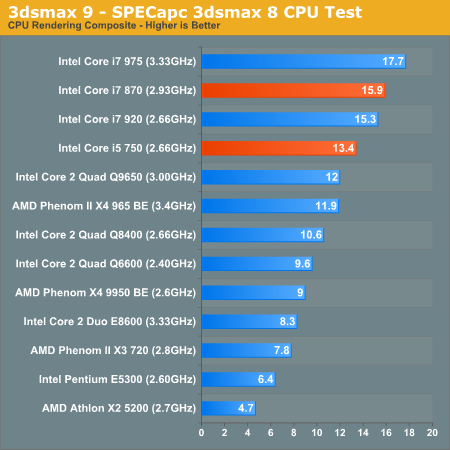
And we're back down to utter dominance yet again. The i5 750 is 12.6% faster than the Phenom II X4 965 BE and 18.8% cheaper. Harder, better, faster stronger.
Blender 2.48a
Blender is an open source 3D modeling application. Our benchmark here simply times how long it takes to render a character that comes with the application.
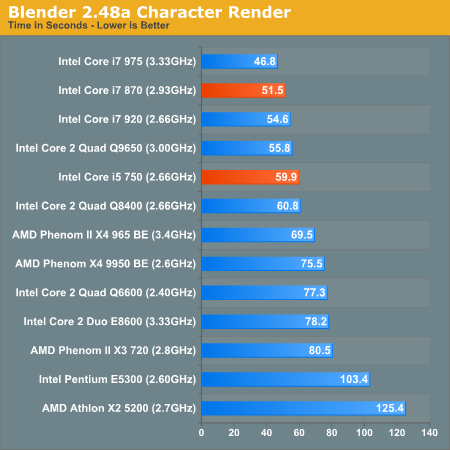
To get Blender to perform right on Lynnfield we actually had to update our graphics drivers. It looks like the on-die PCIe does require the latest NVIDIA/ATI drivers to work properly. The results aren't unusual; Intel has done very well in these tests and Lynnfield continues to dominate. The i5 750 is a bit slower than the 920 (and Q9650) thanks to its missing HT support.
Cinebench R10
Created by the Cinema 4D folks we have Cinebench, a popular 3D rendering benchmark that gives us both single and multi-threaded 3D rendering results.
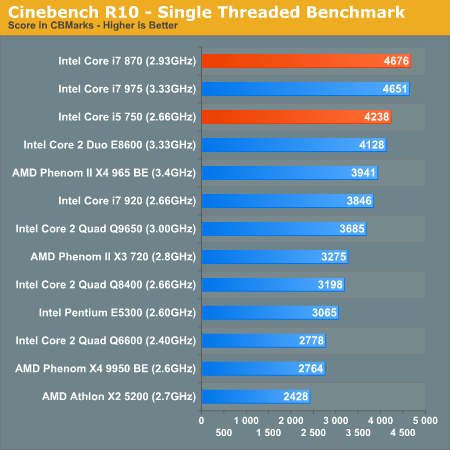
The single threaded benchmark tells us everything we need to know. The Core i5 750 and i7 870 are two of the fastest processors we've ever tested at single-threaded applications. Very few microprocessors will be able to retire instructions from a single thread as quickly as Lynnfield. This is actually very noticeable in simply using the OS. Many tasks still aren't multithreaded but they execute very, very fast on Lynnfield.
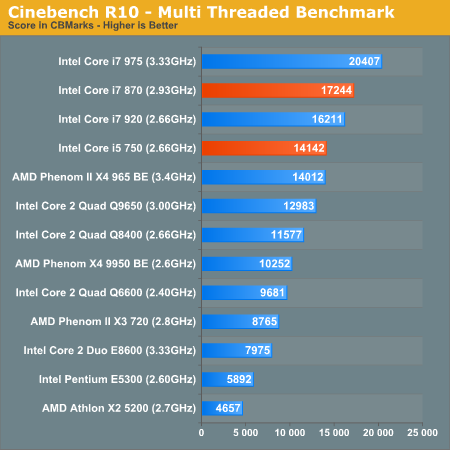
Crank up the threads and Lynnfield is still competitive. Because it's missing Hyper Threading, the i5 750 is barely faster than the Phenom II X4 965 BE. Although I understand Intel wanting to segment its product line, it seems that the i5's missing HT goes a bit too far.
POV-Ray 3.73 beta 23 Ray Tracing Performance
POV-Ray is a popular, open-source raytracing application that also doubles as a great tool to measure CPU floating point performance.
I ran the SMP benchmark in beta 23 of POV-Ray 3.73. The numbers reported are the final score in pixels per second.
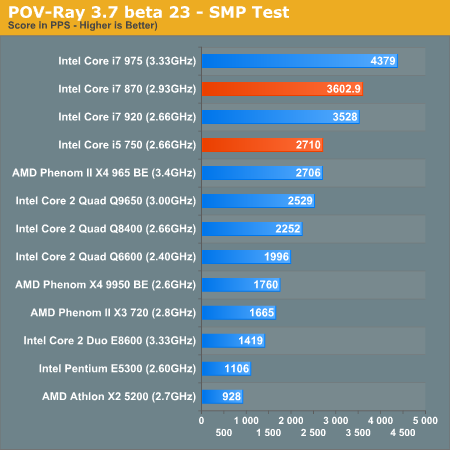
We see the same results under POV-Ray. Regardless of thread count, Lynnfield delivers the best performance possible short of a $1000 CPU.










343 Comments
View All Comments
goinginstyle - Thursday, September 10, 2009 - link
What is worthless here is your continued ramblings about subjects you have no actual knowledge of right now. Do you own a P55 system? If so, let's see an article from you. Really, you come over spouting off and calling everyone idiots, yet, you we do not see any articles from you at Toms about the subject matter. In fact, we do not see any comments from you anywhere else about P55. Toms, Tech Report, and AT all came to the same conclusion, presented the same type of information (although AT discussed subjects like PCIE), and yet you do not comment on those other websites.Either you are posting here because you think your negative posts will somehow get you attention that your mother never gave you or you are doing to try and look important to the people in charge at Toms. I hope to God that they never allow you to post another piece of garbage on their site. Really, that article was a straight copy and paste from several other articles on the subject along with Wikipedia information. I am surprised you were not sued for plagiarism, maybe you were and that is why you are over here.
So far, all of your ramblings have only proved your total lack of intelligence when it comes to computer components. Once again, when will we see you making comments on Toms about their similar coverage or when can you expect to see your expert PP article on the site?
eternalfantasy - Tuesday, September 8, 2009 - link
Fully agree up to the AMD part. This is the most biased review I've seen published by Anandtech to date. I think a "Buy me now!" link at the end of the article with an Intel sponsored Ad will complete the article perfectly.Stock clock speed CPU review is what highstreet mags for average Joes write about. Excluding what's importent for readers of tech sites, such as:
Clock for clock comparison
Maximum overclock with similer priced CPU/platform
is just blatent attempt at glorifying Intel's mainstream platform to look like more then what it really is. A cheaper mainstream alternative to the X58 that has been avaliable over a year ago.
PassingBy - Tuesday, September 8, 2009 - link
As released, Core i5 and 1156 Core i7 have no IGP market, so presumably people reading this review will have no interest in using an IGP.In any case, we can safely say that your prognostications like 'a brain dead platform for brain dead people' were total bullshit, as many people tried to tell you. Now, many more people can place a Nehalem-based system on their list of possible purchases. Clarkdale will extend Nehalem/Westmere to even lower price points (and yes, then you can start comparing IGPs, if you like).
TA152H - Tuesday, September 8, 2009 - link
You're really confused.Honestly, anyone who knows anything about computers would be pretty stupid to get this platform. It's fine stock, but when you throw in overclock, the i7 920 is the better choice.
But, here's your hypocrisy. This article was main for mainstream people, since there's no overclocking comparisons, really. The IGP is what makes AMD work, and they do sell their processors into this market. Anand was commenting on how AMD had to lower their prices, so within this context the entire market is applicable. You didn't understand the context, did you?
I didn't say the platform was brain-dead, although you seem to be. I said it was brain-damaged. It's a Celeron. If you look at the reviews from better sites, you can see the Bloomfield running at the same speed is faster than the brain-damaged Lynnfield. Anand really tried to obfuscate this, by using bad comparisons or those meant to show the Lynnfield in the best light, instead of just presenting the most useful information. He fooled you, because you're a moron, but not everyone.
I do like this site, or I did, but I'm really getting unnerved by the way they test to show what they want to show, instead of test and then make up their minds. It's really problematic, and it's going to bite them when more people figure this out.
imperialsoren - Tuesday, September 8, 2009 - link
You have a nasty way of conversing.IdolObserver - Wednesday, September 9, 2009 - link
It's not only his nasty way of conversing. He also doesn't have a clue what he is talking about.Zymon - Tuesday, September 8, 2009 - link
I agree in the main part - there are many aspects which seem to have been completely ignored in this, and many other reviews of Lynnfield.It seems strange that you haven't used a level playing field between compared systems: ALL 3 platforms can use DDR3 - you've used X48 for Core 2 chips, but apparently used different RAM than i5. Why on earth have you used an AM2+ board and DDR2 ram for AMD? I guess it's *only* been 9 months since AM3 became available?
As mentioned, a true clock-for-clock comparison would be VERY interesting, using the same RAM, at the same speeds and timings between platforms.
Anand Lal Shimpi - Tuesday, September 8, 2009 - link
Sorry if this wasn't made clear in the review but the Phenom II X4 965 BE used the same test platform as our review of that CPU: an AM3 motherboard with DDR3 memory.I'm out of the office now but I'll update the test tables later this evening to reflect this.
Take care,
Anand
Zymon - Tuesday, September 8, 2009 - link
Cheers for the clarification Anand!- It seemed unusual for one of your articles, hence the comment!
Laters..
snakeoil - Tuesday, September 8, 2009 - link
i want to know if those benchmarks were with the turbo enabled, which would be cheating, because that's overclocking.for every benchmark turbo must be disabled to be fair.
readers are not stupid.